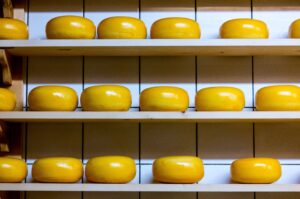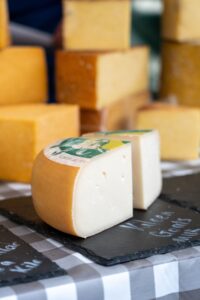Babybel cheese, with its distinctive wax coating, has become a beloved snack for many. The iconic wax layer not only adds to its appeal but also serves a purpose in preserving the freshness and quality of the cheese. However, as environmentally conscious consumers, we often question the compostability of materials used in our everyday products. This leads us to ponder: Is Babybel wax compostable? Understanding the compostability of Babybel wax is crucial for those seeking to make environmentally responsible choices. By exploring this topic, we can gain insights into the impact of Babybel Cheese on waste management and the environment.
Contents
Understanding Babybel Wax
Babybel wax is a unique coating that envelops the beloved cheese, ensuring its freshness and extending its shelf life. The composition of Babybel wax primarily consists of two main components: paraffin and microcrystalline wax.
Paraffin wax, derived from petroleum, forms a significant portion of the wax coating. It is a type of mineral wax with excellent sealing properties, effectively shielding the cheese from external factors such as air, moisture, and contaminants. Paraffin wax helps maintain the cheese’s texture, flavor, and quality.
Microcrystalline wax, a byproduct of the petroleum refining process, is also present in Babybel wax. This type of wax adds flexibility and durability to the coating, ensuring it remains intact during handling and transportation.
The combination of paraffin and microcrystalline wax creates a protective layer around the Babybel cheese, acting as a barrier against spoilage, mold, and drying out. This coating allows Babybel cheese to remain fresh and delicious, ready to be enjoyed anytime.
Exploring Compostability
Compostability is the ability of a material to break down naturally and turn into nutrient-rich compost through composting. Composting is an environmentally friendly waste management method that transforms organic waste into a valuable soil amendment, reducing waste sent to landfills.
While some waxes, such as beeswax and soy wax, are known for their compostable properties, it is important to note that paraffin and microcrystalline waxes, the main components of Babybel wax, are not inherently compostable. Unlike biodegradable materials that naturally decompose over time, these petroleum-derived waxes do not readily break down in composting systems.
Beeswax and soy wax, on the other hand, are examples of natural waxes that can be compostable. These waxes are derived from renewable sources and can break down in composting environments, eventually enriching the soil with their organic matter.
Regarding Babybel wax, its paraffin and microcrystalline wax composition renders it unsuitable for composting. These waxes do not readily break down and may pose challenges in composting systems. Therefore, it is advisable to consider alternative disposal methods for Babybel wax.
Factors Influencing Compostability
The compostability of materials is influenced by various factors, including the composting methods and facilities used for their decomposition.
Composting methods and facilities play a crucial role in determining the compostability of different materials. Industrial composting facilities have specialized processes to handle various organic waste, including certain non-compostable materials. These facilities often operate at higher temperatures and have controlled conditions that promote faster decomposition. Consequently, industrial composting facilities can potentially process non-compostable materials like paraffin wax more effectively.
On the other hand, home composting systems, such as backyard compost bins or vermicomposting setups, are typically designed to handle biodegradable and compostable materials. These systems often operate at lower temperatures and rely on natural microbial activity to break down organic waste. As paraffin and microcrystalline waxes are not readily biodegradable, they may not decompose efficiently in home composting systems. It is generally recommended to avoid adding Babybel wax to such systems to prevent potential issues and ensure optimal composting conditions.
Therefore, while industrial composting facilities may be able to process non-compostable materials like paraffin wax, home composting systems are generally unsuitable for composting Babybel wax due to its composition. It is important to consider the specific composting methods and facilities available to you when determining the appropriate disposal route for Babybel wax.
Disposal Recommendations
When disposing of Babybel wax, following proper waste management guidelines is important. Here are some recommendations for the disposal of Babybel wax:
1. Consult Local Waste Management or Recycling Guidelines: Waste management practices vary depending on location. It is advisable to consult the specific guidelines provided by your local waste management or recycling authorities. They will offer detailed instructions on handling and disposing of materials like Babybel wax in your area.
2. Dispose of Babybel Wax in Regular Waste Bins: In most cases, Babybel wax should be disposed of in regular waste bins. This ensures that it is properly contained and disposed of following standard waste management practices. Place the used wax in a secure bag or wrap it in paper before disposing of it to prevent mess.
3. Consider Recycling Options: Depending on your region, recycling the packaging of Babybel cheese may be possible. Check with your local recycling guidelines to see if the plastic packaging can be recycled. However, remember that the wax coating is not typically recyclable, so it should be separated from the packaging and discarded as regular waste.
Remember, the best course of action is to consult your local authorities’ specific waste management guidelines. By following their instructions, you can ensure that Babybel wax is disposed of appropriately and environmentally responsibly.
Considerations for Environmental Responsibility
When evaluating the environmental impact of Babybel Cheese, several factors come into play. Here are some key considerations for environmental responsibility:
1. Broader Environmental Impact: While the compostability of Babybel wax may be limited, it’s important to assess the overall environmental footprint of the product. Babybel cheese packaging is typically made from polyethylene, a recyclable plastic in many regions. By recycling the packaging, you can reduce waste and promote a circular economy.
2. Recyclability of Babybel Packaging: The polyethylene packaging used for Babybel cheese is generally accepted by recycling programs. When disposing of the packaging, check with local recycling guidelines to ensure it is properly recycled. Recycling reduces the need for virgin materials, conserves energy, and mitigates the impact on natural resources.
3. Portion Control and Reduced Food Waste: Babybel cheese’s individual serving size promotes portion control, which can help minimize food waste. By offering pre-portioned servings, Babybel helps consumers avoid excess cheese that may go uneaten and potentially end up as waste. This reduction in food waste contributes to a more sustainable food system.
Considering these aspects, you can make informed choices that align with environmental responsibility. While Babybel wax may not be compostable, focusing on recycling the packaging and appreciating the portion control benefits can contribute to minimizing the overall environmental impact associated with Babybel cheese.
Conclusion
In conclusion, it is evident that Babybel wax, composed primarily of paraffin and microcrystalline wax, is not compostable. While certain waxes like beeswax and soy wax possess compostable properties, the composition of Babybel wax renders it unsuitable for composting. It is crucial to adhere to proper waste management guidelines to ensure the responsible disposal of Babybel wax.
To dispose of Babybel wax, consult your local waste management or recycling guidelines. These guidelines provide specific instructions tailored to your region. In most cases, Babybel wax should be placed in regular waste bins, securely bagged or wrapped to prevent any mess. Additionally, consider recycling the polyethylene packaging of Babybel cheese if recycling facilities in your area accept it.
While compostability is an essential consideration for environmental consciousness, it is not the sole factor in evaluating the overall environmental impact of a product. By focusing on other environmentally responsible aspects, such as recycling the packaging and embracing portion control to reduce food waste, consumers can make positive contributions to sustainability.
In your journey towards environmental responsibility, remember to stay informed and prioritize the practices and guidelines that best align with your local waste management systems. We can collectively work towards a more sustainable future by making conscious choices.
More Posts :
The Ultimate Guide: Recycle Crushed Water Bottles for a Greener Future – 2023
Revolutionizing Recycling: The Highlands Recycling Center Ocala Leads the Green Movement in 2023





